Last month I was invited to embark on the USS Toledo SSN-769, a newly refurbished Los Angeles class nuclear attack submarine for a trip down the East Coast. The visit was designed to give me an opportunity visit with the crew and get an idea for the technology, environment and mission of the USS Toledo and her crew.
The USS Toledo, Sword of Freedom arrived to pick up a small group of people at Cape Canaveral’s turning basin. After a quick orientation to safety issues including how to survive a fire onboard, introduction to the command structure and layout of the boat, we got underway transiting out of the turning basin and Eastward into the Atlantic.
The mission of the USS Toledo is principally a deterrent to aggression, though other missions can and do involve intelligence gathering, anti-ship and anti-submarine operations, strike, mining, search and rescue and discrete insertion of special forces. The Los Angeles class submarines currently form the backbone of the US submarine fleet with a total of 45 boats in the class currently active.
The USS Toledo is one of the final 23 boats in the class that were designated “improved” boats that run quieter with more advanced combat and navigation systems. Additionally, they were designed for under-ice operations by moving the forward dive planes from the conning tower to retractible positions in the bow of the boat.
Much has been written about the statistics and capabilities of these boats, but the absolute limits of these submarines are classified. Nominally, they are capable of 25 knots and maximum operating depths of greater than 800 feet. The reality of course is that the boats operating envelope is significantly greater with greater test and crush depth ratings and flank speed ratings underwater of 30-32 knots. For the record, we were cruising right around 650 feet at 20 knots for a good portion of our journey down the coast.
The USS Toledo was originally commissioned back in 1995, but entered into a Depot Modernization period in 2007 in Newport News, Virginia where extensive upgrades to the boats sonar, combat and weapons systems was undertaken, upgrading these systems to keep ahead of developments in other submarine based platforms operated by competing navies. This cruise is part of the redelivery of the boat after redelivery from Depot Modernization on February 21st.
While the USS Toledo is one of the smaller submarines that the US Navy operates, they are still 360 foot long machines with a 33 foot beam and a surface displacement of over 6,200 tons. The Los Angeles class submarines are organized into 2 principal compartments including engine compartments housing the reactor and all of the engine and turbine components as well as the desalination plant. This compartment occupies approximately the rear half of the submarine. The forward compartments house all the living space, weapons systems, control centers, sonar and fire control on three main decks. On the first deck below the sail containing the bridge and all of the periscopes, radar masts and most communications arrays is the control room, sonar and attack centers. The second deck down contains the mess decks, berthing and ward room while the lower deck is occupied by the torpedo room including all of the torpedo stores, Tomahawk cruise missiles and mines. This is also the location of the forward Tomahawk vertical launch controls.
The boats compliment is typically 14 officers and 132 enlisted men. For this cruise, there were a few extra individuals on board including a Navy physician, Dr. Vanderweele.
As we transited into the Atlantic, I had the opportunity to spend some time up on the bridge, enjoying the sunshine, watching dolphins play off the bow wake and I can honestly say it was one of the highlights of the trip. There were far more interesting things to come, but the simple pleasure of moving through the ocean with a view around you unencumbered by superstructure or other obstructions is unparalleled in the US Navy.
The origins of the Los Angeles class submarines began with the height of The Cold War. At the time, the Los Angeles Class submarines were designed to function almost exclusively as carrier battlegroup escort submarines. They were intended to maintain a new technological peak of weapons capabilities as well as functioning as some of the quietest submarines in the world. With the fall of the former Soviet Union, many of the original purposes of the Los Angeles class submarines were put into doubt, yet today the mission scope of these submarines and their crews has significantly expanded as these are ideal platforms that can quickly and discretely respond to global changes in geopolitical status that impact the United States. These submarines can deploy with very little notice or stay on station for extended periods of time that can last months and carry out diverse operations.
Submariners are actually double volunteers. Principally, they volunteer for military service which includes eight weeks of basic training and indoctrination into US Navy life, then individuals wanting to become submariners subsequently volunteer for submarine duty. Upon being selected for submarine duty, a submariner obtains specific training for another eight weeks in submarine school learning about fire fighting, escape techniques, physics, and other aspects specific to living and working on a submarine.
All sailors also attend schools designed to give them skills related to their specific jobs on the submarine. These schools teach everything from the fundamentals of electronics or of nuclear power-plant operations, navigation, mechanics and more. The Naval Postgraduate School also offers courses to officers in engineering acoustics, physical oceanography, electrical engineering, operations research including tactical applications and even courses of study in applied mathematics and computer science. Classes are even offered onboard the submarine through independent distance learning programs allowing sailors to use the crew mess as both classroom and study area to work on both certificates and degrees.
The crew of the USS Toledo are highly independent with redundant training to solve problems in an environment where there is no calling for help when things go wrong. There are two principal tasks onboard: The operation of the submarine along with its nuclear power plant and maintaining combat readiness of the combat systems. Because of this, training is a constant and daily occurrence.
Interestingly, unlike Russian and Chinese submarine fleets, typically the most junior Navy members crew the helm of the submarine, giving a huge amount of responsibility to crew members as young as 19 or 20. In the Russian and Chinese Navies, only the most senior members of the crew man the helm.
All told, I was absolutely impressed with the crew of the USS Toledo. I met some of the smartest folks onboard and two of them, PO3 Gumina and PO3 Dale struck me as two of the most quiet, yet intelligent sailors I’ve ever met with interests and talents in chemical engineering and languages respectively. Others like PO2 Powers plans to go onto medical school, taking a course similar to Lt. Vanderweele. This culture of course is like most other DOD operations, run in a top-down fashion and owes its feel to Cdr. Reckamp. The Captain of the boat, Cdr. Reckamp and I had a wonderful discussion about emergent properties of command structures and how that relates to aggregation of information and group decision making and the value of letting everyone have a voice. I was also pleased when our discussion turned to the history and philosophy of science and the ramifications for modern naval practice and the sociopolitical implications of a modern US Navy.
The crew of the USS Toledo is supervised by Cdr. Reckamp and LCdr. Davis and organized around six separate departments including Combat, Engineering, Executive, Navigation, Medical and Supply. Each department is staffed by crew to perform specific duties related to the daily operation of the submarine and the care of her crew.
All weapons systems are controlled through the Combat Systems Department, supervised by Lt. Lancaster. On the USS Toledo, this department has four separate divisions including Torpedo, Fire Control, Sonar and Deck. The Torpedo Division is manned on the lower deck in the torpedo room by a Machinist’s Mate. Fire Control is concerned with approach and attack parameters, while the Sonar Division, situated next to Fire Control and the Control Deck works with all three divisions to detect and direct appropriate information about any sonar based contacts to the appropriate division.
Communication between all divisions of the Combat Systems Department is routine and operates in a round robin fashion when surfacing or making any transitions as contacts and bearings are called out to Fire Control who maintains targeting solutions on all contacts and Command who makes appropriate decisions concerning those contacts.
Armament is substantial. The USS Toledo carries upwards of 14 torpedo tube launched weapon systems that can include traditional Mk48 ADCAP torpedos fired through 4 forward torpedo tubes. In addition, there are 12 vertical launch tubes designed to launch Tomahawk cruise missiles making conventional or nuclear attacks on land or sea at distances of up to 2,500 km away.
The sonar room functions as the eyes and ears of the submarine. Because of the mission, this division is absolutely critical to maintaining or preventing contact, gathering intelligence and ensuring that the submarine itself is operated in a quiet fashion.
Commercial off the shelf technology (COTS) is a driving force in the US Navy and with the refurbishment and improvement of the weapons and sonar systems. Since the recent retrofitting, the USS Toledo now has a new sonar array with over 1000 individual sensors embedded in the bow that comprise the Acoustic Rapid COTS Insertion (A-RCI) program. This sonar system was essentially the driving motivation behind the Depot Modernization program to modernize the SSN-688 class submarines and give them an additional edge against new foreign diesel electric submarines
the USS Toledo operates the latest Raytheon AN/BYG-1 combat system and sonar system. The AN/BYG-1 comprises a group of systems involved in tactical control, weapons control and networking. Sonar operations provide for acoustic detection, tracking and localization, recording and analysis. Some data handling and data classification from the flank sonar array, the cylindrica
l sonar, passive ranging sonar, TB-29A twin line towed array and internal noise monitoring through submarine wide embedded accelerometers operate through this system. Ocean floor mapping and mine avoidance are also included in this system to collect data and avoid ocean hazards, natural and battlefield related. Interestingly, the new TB-29A towed arrays provide upward of 400-500% increase in signal detection capability of other quiet submerged platforms as the previous TB-29 array minimizing some of the concern made a few years ago about the new generations of diesel electric submarines being fielded by competing navies.
Additionally, a new AN/BLQ-10 SIGINT system provides management of sensors, and receivers in a new generation of processing, analysis and display systems to provide for more precise detection and identification of ships, aircraft, submarines and other sources of acoustic noise.
I was actually surprised that more modern data handling and multi-spectral data display functionality has not made it into the latest submarines. In a sense, modern submarines are still using the same paradigms for listening to, detecting and tracking sonar contacts that they have used for decades. Regardless, STSC Chief Roby and I talked extensively about ways of displaying and clustering frequency and time-space domain data. Hopefully some of the new technologies being developed for data visualization will begin the migration into modern platforms before too long. Anything that can help the operators deal with complex data or alert to certain acoustic signatures would be a good thing for operators. Of course this is an old, old problem with highly trained human analysts being able to function with more accuracy and speed than computational systems, but even in data display, there are improvements that could be made.
That said, the capabilities of the sonar operators to interpret sonar information is impressive. The capability to determine biologic signals (whales, fish, even shrimp feeding) from surface ships is pretty straight forward, but other sonar data such as aircraft or ship traffic and classifying that activity into type, speed, heading and the number of propellers while it is influenced by water temperature, salinity and even ocean bottom geological activity is impressive indeed.
The Navigation and Operations Department is concerned with navigation and radio operations. All operations related to moving the boat through coastal and restricted waters or coming into or out of port falls to this department. They have a number of tools they can use including radar, navigation charts and the boats two periscopes. Additionally, they have access to the Ring Laser Gyro Navigation System (RLGN) allows for highly accurate navigation to provide firing solutions for the Tomahawk cruise missiles 24 hours a day from anywhere on the globe to support strike operations. The current system from WRSystems, the IP-1747/WSN uses an enhanced display that receives data from combined RLGN, embedded global positioning satellites and other conventional navigation sources and distributes those data to combat control systems, sonar, radar and other appropriate users on the network.
The engineering department which operates the S6G nuclear reactor onboard the submarine. This reactor is core rated at 165 MW and consists of the reactor core, reactor coolant, steam generation and other support systems. These are entirely closed systems composed of two portions that recycle and reuse water to transfer heat from the reactor core through steam generators that supply steam to the turbines and main engines of the submarine. Operations here also provide oxygen generation as well as CO, hydrogen and CO2 scrubbing of the atmosphere within the submarine as well as provides distilled water.
It should be noted that nuclear submarines are actually some of the greenest travelers on or under the ocean. They consume essentially no petroleum products while underway and use nuclear power to provide light, heat, cooling, circulation and air filtration, potable water and electricity to power the boat. Incidentally, there is a backup diesel generator on board that can be brought online in case of emergency, but is never operated under typical operations for anything other than maintenance.
If you are concerned about radiation exposure, there are certain areas of the boat that limit the amount of time you can be in them, but the reality is, while on a nuclear submarine, because of all of the shielding and the water around you, radiation exposure is actually less than if you were standing on the beach watching the ocean. Just to be safe however, every crewman wears a radiation dosimeter at all times that is checked periodically for total radiation exposure.
Medical departments on most deploying submarines are manned by a Hospital Corpsman, equivalent to a physicians assistant who has extensive training to operate independently from a medical officer or physician. This training allows the corpsman to treat everything from everyday headaches and minor injuries to everything short of major surgery. Space is at a premium on board a submarine, but there are extensive facilities onboard to treat medical issues. I was surprised at the level of redundancy when I found out that when necessary, the wardroom table we ate dinner at becomes the surgery table.
This particular trip did have a physician on board and Dr. Vanderweele and I had a wonderful discussion about the environment of the submarine and the routine the sailors adopt. Most sailors live 18 hour days with six hours on watch and 12 hours for submarine maintenance, training, rest and recreation. There are 3 watch shifts or sections on the submarine.
Given that humans have an intrinsic 25 hour circadian rhythm that fits into a 24 hour day, there may be valid issues associated with that schedule. We also talked about lighting onboard which some percentage of sailors complain bitterly about. The new “broad spectrum”, low level fluorescent lighting used onboard many submarines gives some headaches, and honestly does not adequately represent enough light to approximate what one might expect of the spectral benefits of daylight. Light issues aside, there are plenty of stimuli on board to ensure an entrained circadian rhythm, but the question of illumination is a valid one. Issues of diet were another area that the Office of Naval Research is concerned with and those discussions were equally illuminating. The prospect of medical research onboard submarines is interesting indeed. The question then becomes how much more optimized could one make the experience? Would changes to the current scheduling or lighting improve morale or performance? Would it minimize sleep disorders, increasing the performance capability of submariners? These are of course “softer” questions than ones related to more proximal mission based issues of submarines such as escape suits that the Navy is typically concerned about, but they are interesting nonetheless.
LtJG Boatwright is the officer in charge of the Supply department that handles logistics and support functions for the USS Toledo related to everyday readiness and combat, inventory control, operations analysis, materials management in addition to contracting and fiscal management. Supply officers or CHOPs (short for pork chop which the Navy Corps Supply staff insignia resembles) supervise a small staff on the submarine including the food service as well.
It turns out that the food onboard a submarine is some of the best in the DOD. There are four meals served onboard every day including breakfast, lunch, dinner and midrats or mid day rations. We ate quite well onboard and I had the opportunity to enjoy meals with the officers and enlisted crew in the ward room and crew mess respectively. Meals can consist of prime rib, sauteed mushrooms and vegetables with baked potatoes and even fresh baked bread amongst other popular favorites as fresh baked pizza on Saturday nights. The ever popular and oh so tasty gummy bears can also be found in the crew mess.
Quality cuisine has long been considered an integral part of submarine life and a reward for the hazards negotiated by submarine crews and as a way to keep morale up on long deployments of 90 days or more. It turns out that because these are nuclear submarines, the only practical limit to how long they can stay deployed or underwater is how much food they can carry for the crew.
In the ward room or officers mess, food is served at the table from a passthrough, while in the crews mess, there are 5 tables that the crew sits down at in rotations to eat food from a buffet lined up along the back of the mess. You can eat as much as you’d like and the food is plentiful, all prepared from the smallest of galleys adjacent to the crew mess. The galley is a full service kitchen with two ovens, a walk-in freezer and refrigerator, a fryer, mixers, broiling ovens and microwaves in addition to a range all to prepare the approximate 15,000 pounds of food for any given patrol. I actually wish I had more time to talk with the kitchen crew as culinary preparation in difficult environments is a bit of a fascination for me… Perhaps next time.
Though life onboard a submarine can be difficult, in addition to the aforementioned cuisine, there are recreational activities available including movies seen on a number of large flat panel screens throughout the boat, board and card games, video games, music from iPods that seem absolutely ubiquitous throughout the submarine, a diverse library onboard and even exercise equipment back in the engine room.
Sleeping quarters are tight as expected with the only private space in the submarine being the captains stateroom and the executive officers (XO) stateroom. In fact, even the captains quarters has multiple purposes as it also serves as the location for damage control communication when surfacing, operating around port or in combat operations. Sailors have their own lockers and sleep six hours per the aforementioned 18 hour day. As previously mentioned, there are 3 shifts per day and it is typical for one third of the boats crew to be asleep at any one time. Bunks are snug without much space to sit up, but they are comfortable and it is easy to fall asleep once the curtains are drawn. Additionally, I was surprised at how quiet submarines are without all the noise associated with surface ships and once you are under water, the ride is exceptionally smooth and stable.
Ascending and descending through the ocean is smooth as can be until surfacing or descending at what are termed “Angles and Dangles”. Angles and Dangles are practiced right after a submarine leaves port and enters deep water and are essentially steep dives and climbs at angles up to 25 degrees. The point is to ensure that there is nothing improperly stowed or unsecured that could come loose and fall down, making noise. Anything that can make noise aboard a submarine or come loose making noise at unexpected times is anathema to submariners, so the angles and dangles are an exercise intended to rig a submarine for silent running.
Surfacing a submarine is a critical time, particularly around crowded ports. Activity on the command deck becomes intense as sonar calls out contacts to fire control and those contacts are relayed to the commander or bridge officer for confirmation. Bringing a submarine to the surface occurs in stages relying exclusively on sonar contacts first, making sure there is nobody around that can be involved in a collision. When the submarine reaches periscope depth, all sonar contacts are confirmed by visual sighting through the periscope, day or night as modern periscopes are equipped with night vision capability, both still and video camera recording capabilities, telephoto capabilities and additional signals intelligence options.
Surfacing was interesting and I realized that the usual smell of the ocean is not part of life onboard a submarine when submerged. It was only when the hatches were opened and we went topside coming back into port that I could smell the ocean again. This is absolutely not the case on other Navy ships as the everpresent smell of the ocean permeates everything.
Transitioning into port is another process whereby Navy swimmers are positioned fore and aft to rescue any crew that might fall overboard due to wave or other action. Tugs deploy to assist turning and positioning of the submarine and in civilian ports, harbor pilots are typically brought on board to help navigate the shipping channels. This particular port, we were positioning the USS Toledo next to the USS Forrest Sherman to save the US Navy (and the taxpayer) mooring costs and to help increase security on the submarine. Armed watches are always in place when the submarine is in port, but the extra buffer of having a guided missile destroyer moored between the dock was convenient.
Thank you to the US Navy, Cdr. Reckamp and the crew of the USS Toledo for inviting me into your place of work and home and many thanks to Chief Lohmeyer for negotiating clearances.
Content in this entry has appeared in the following publications:
War is Boring here.
War is Boring, The Diplomat, Will US Reverse Defense Cuts?
Medium: War Is Boring: Inside the World’s Deadliest Warship
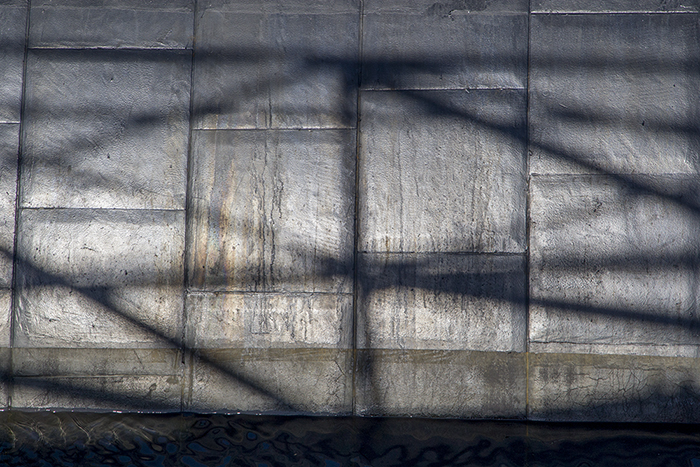
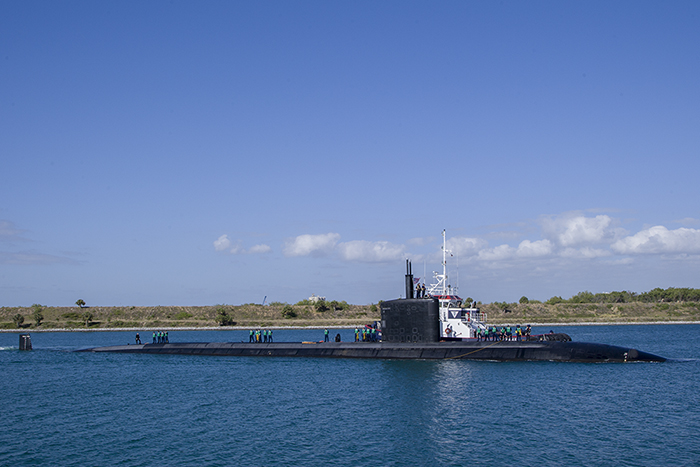
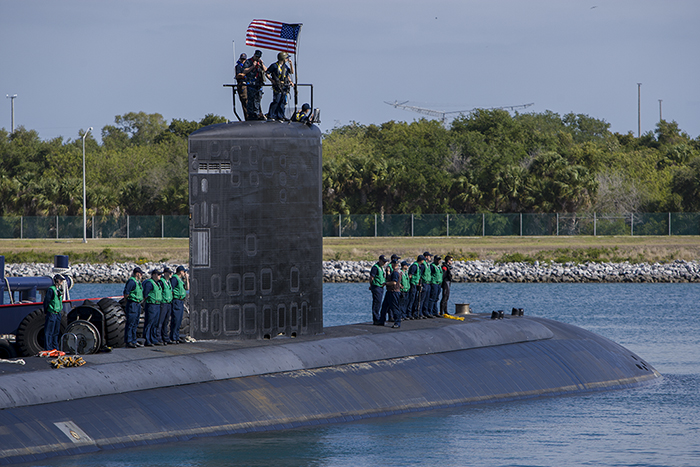
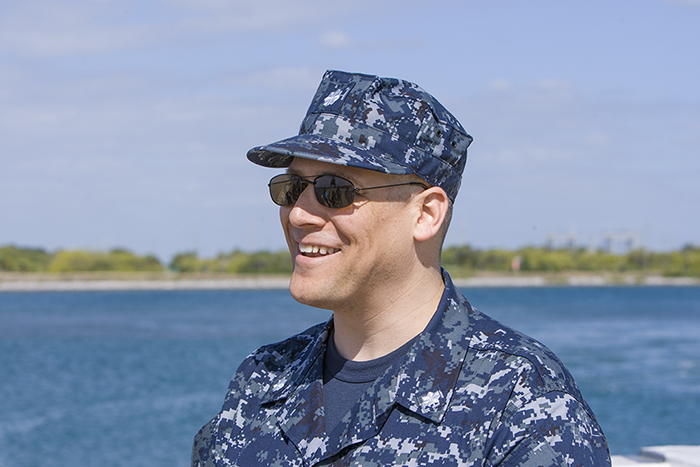
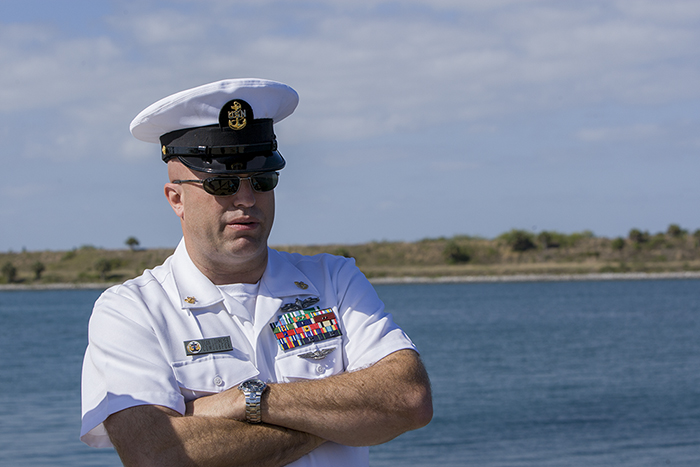
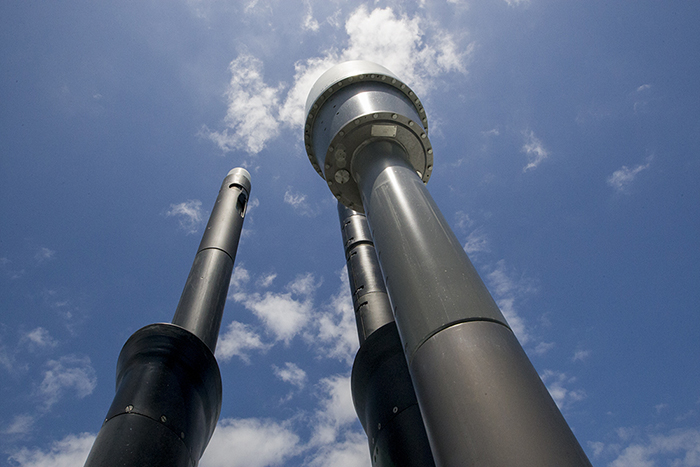
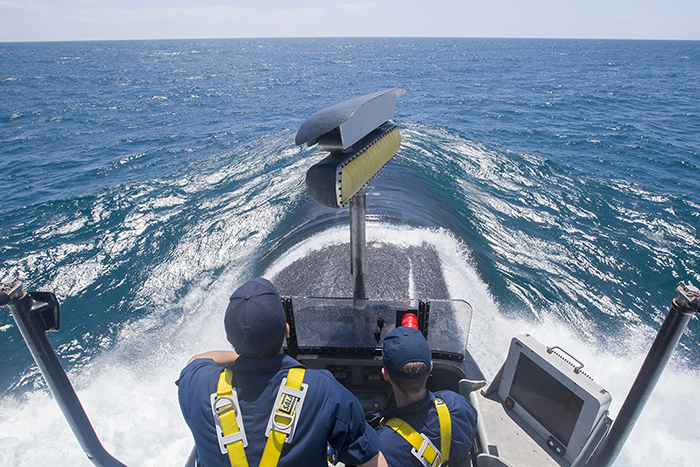

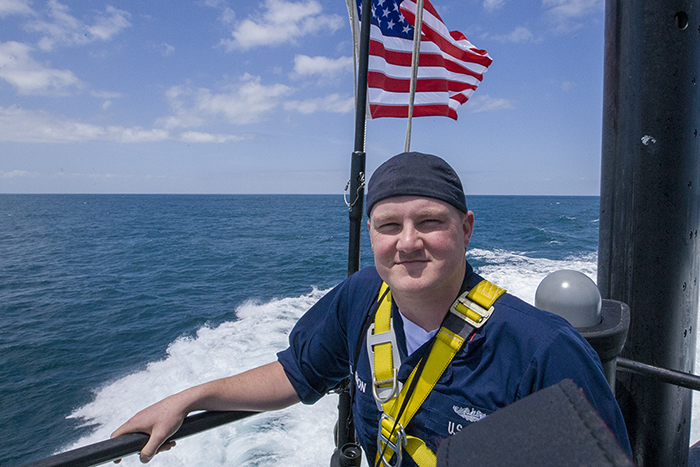
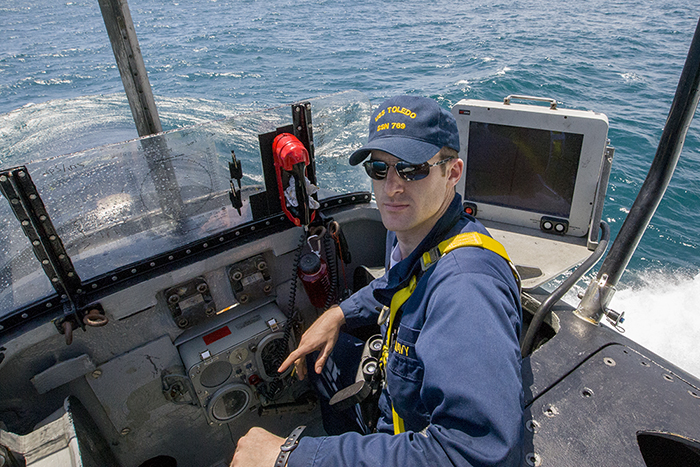
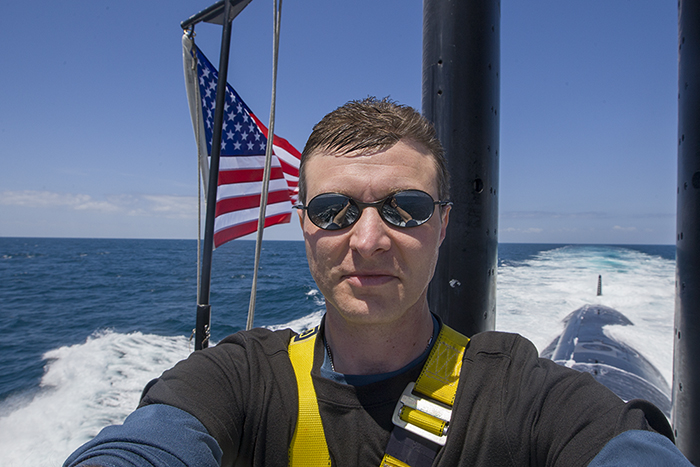
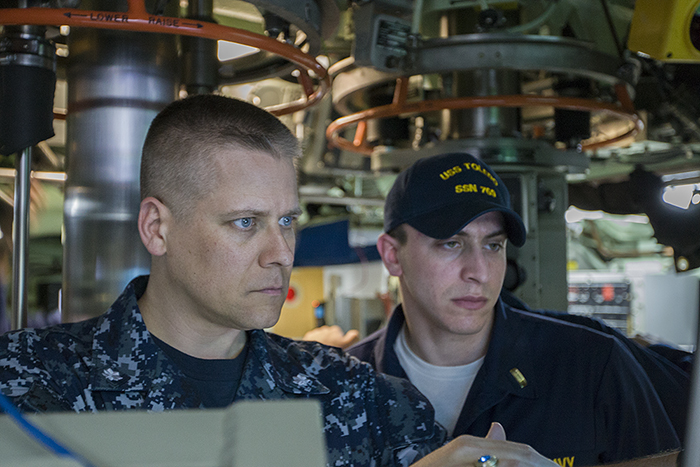
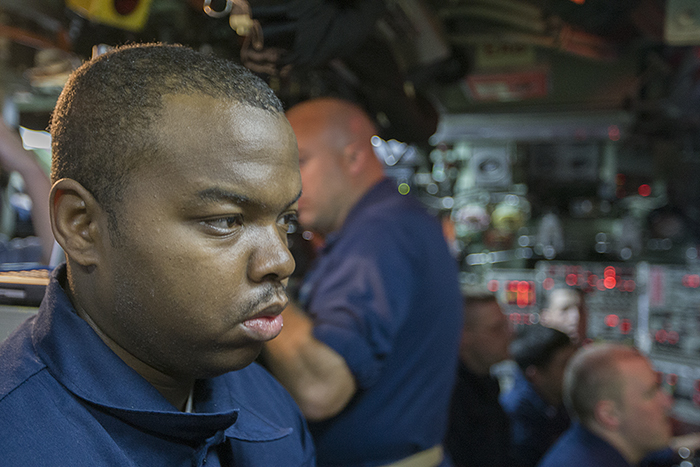
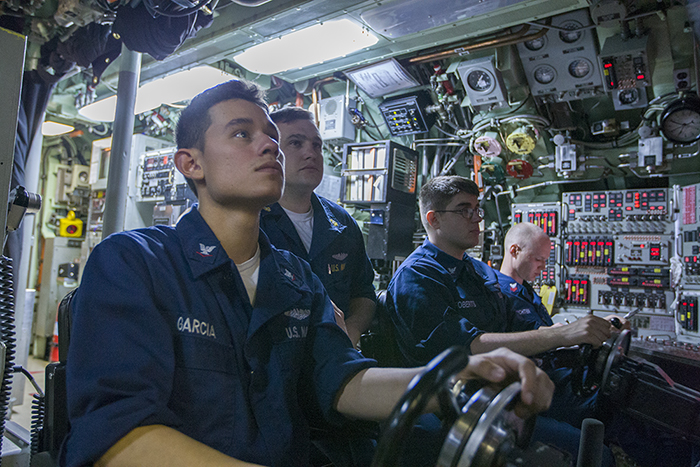
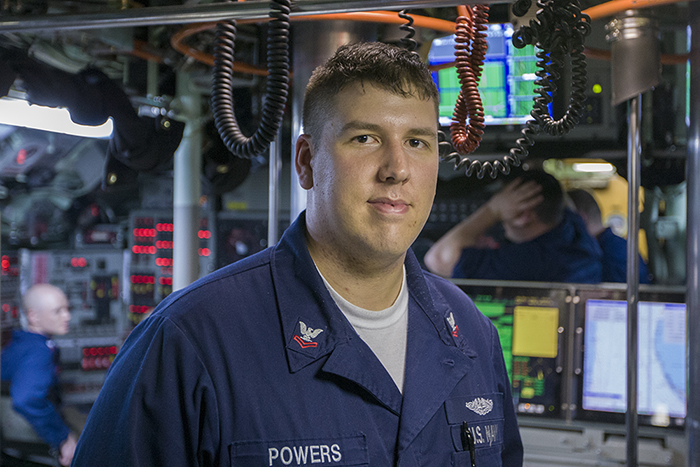
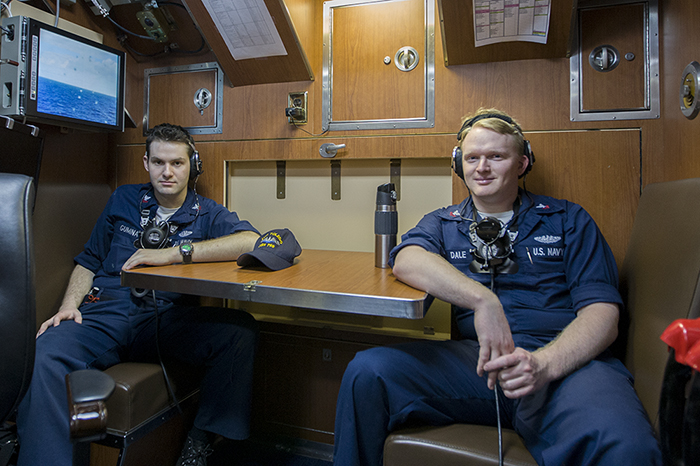
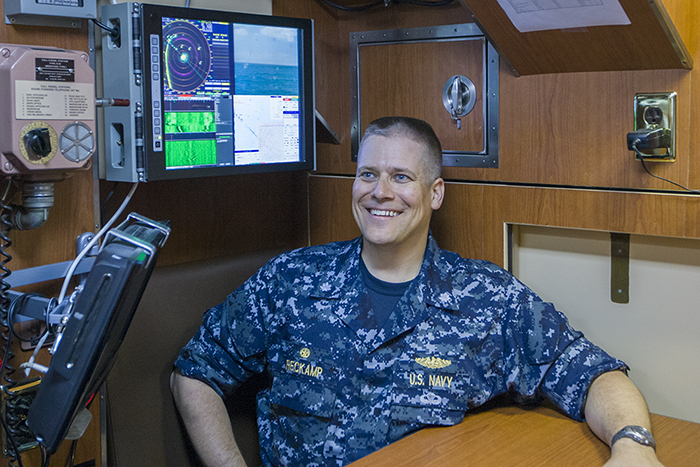
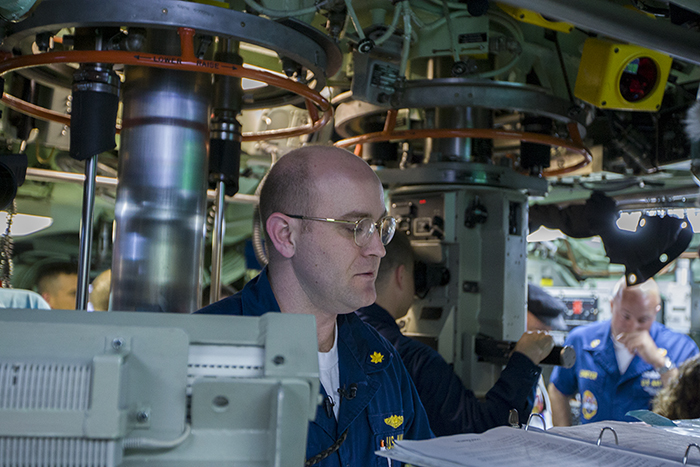
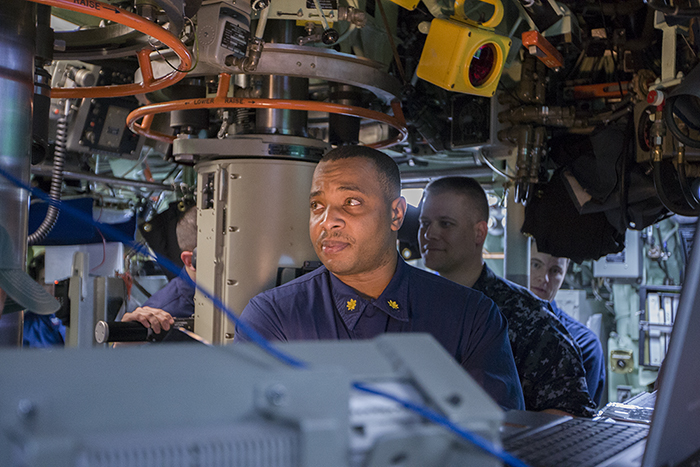
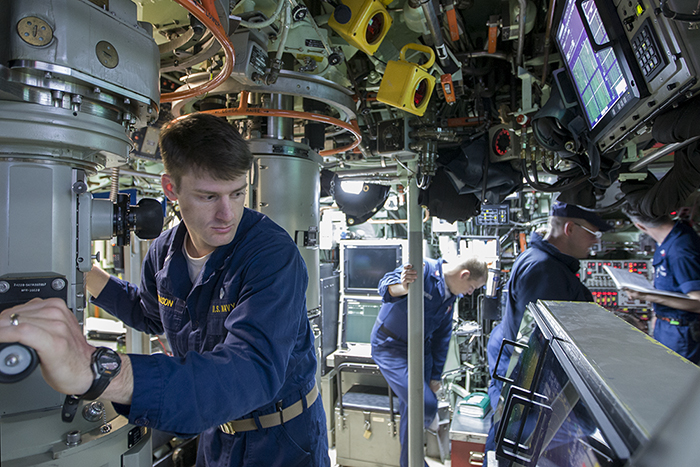
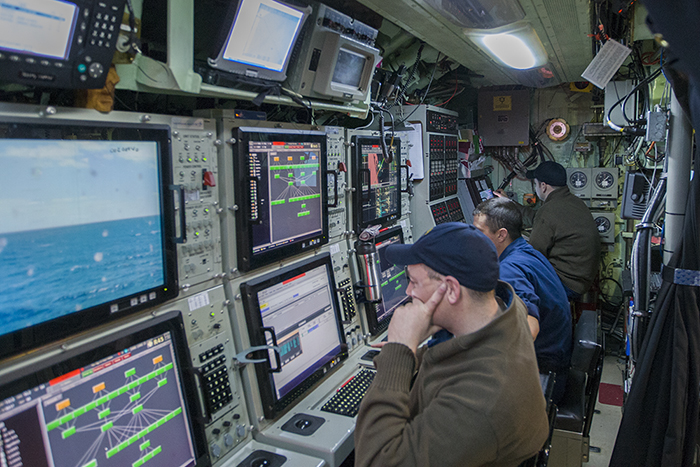
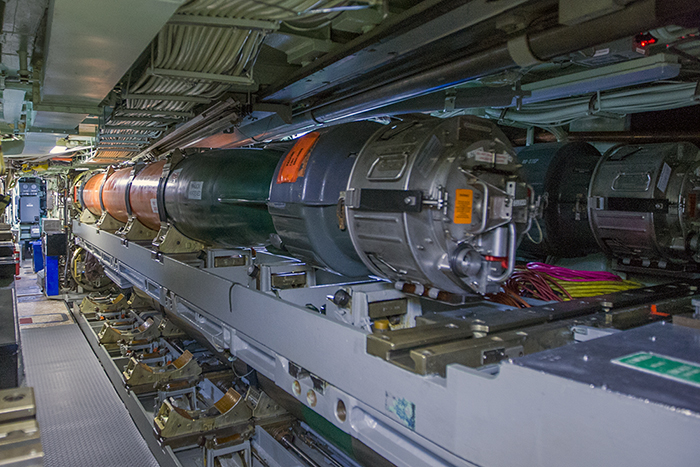
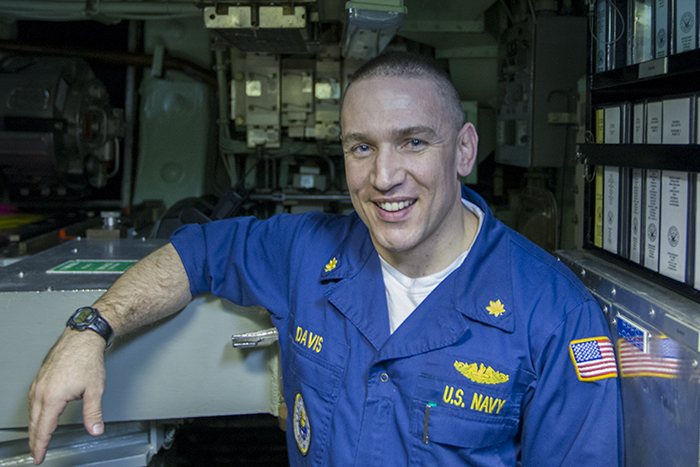
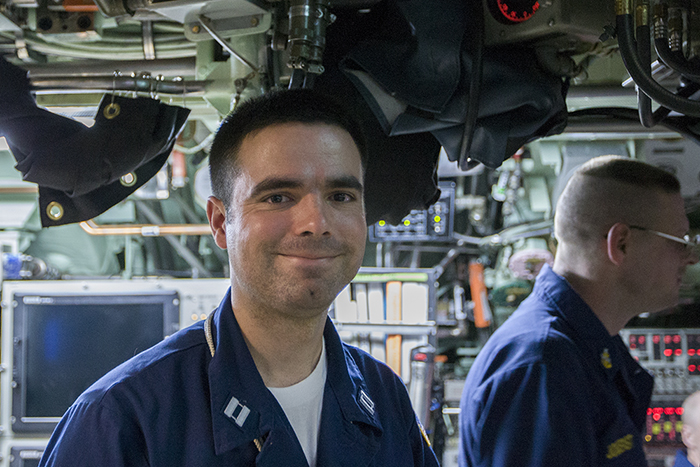
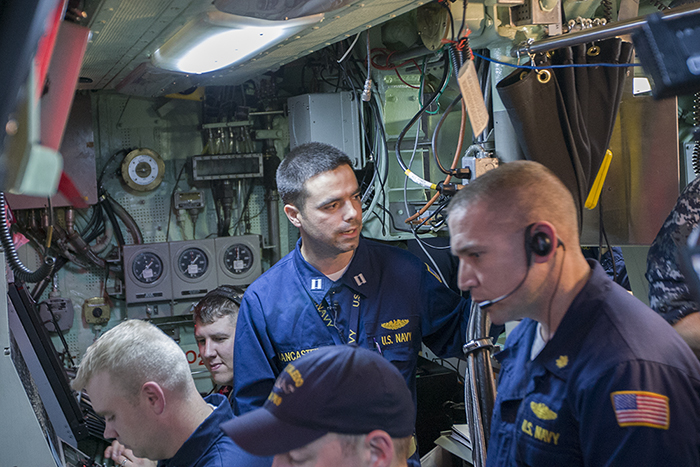
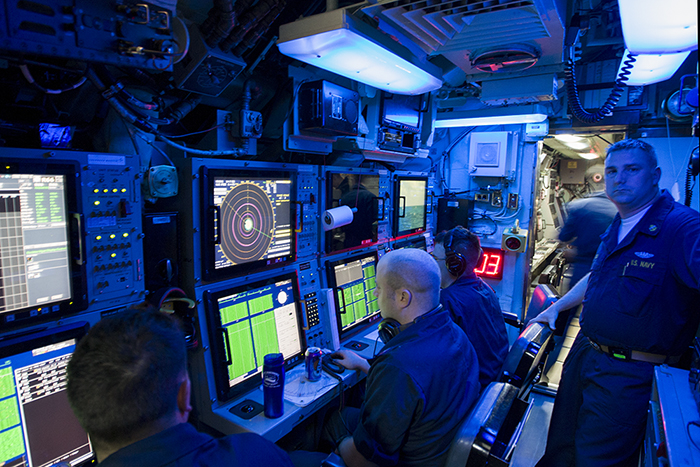
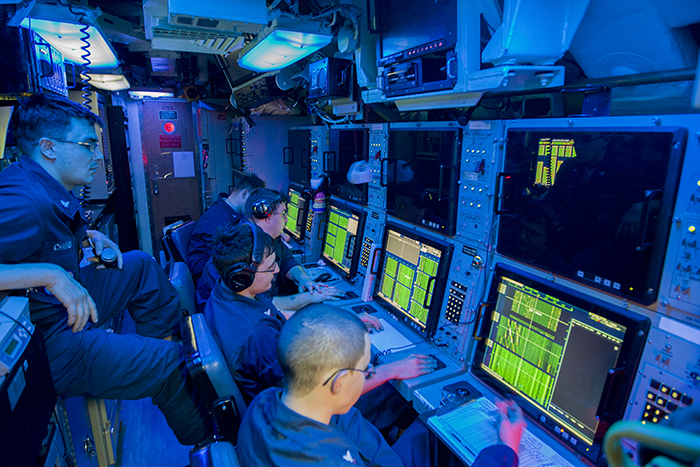
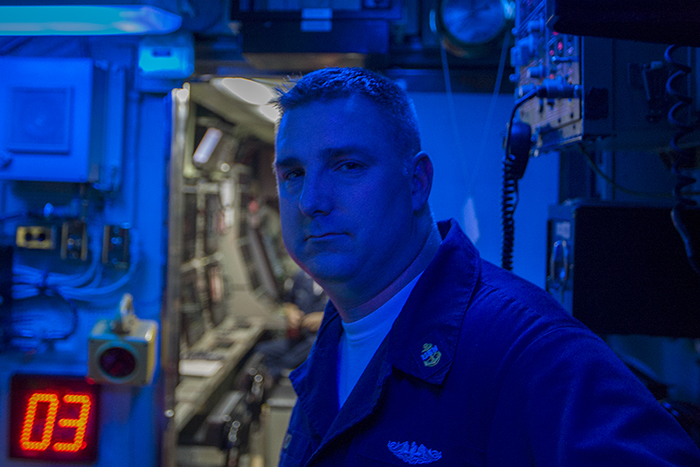
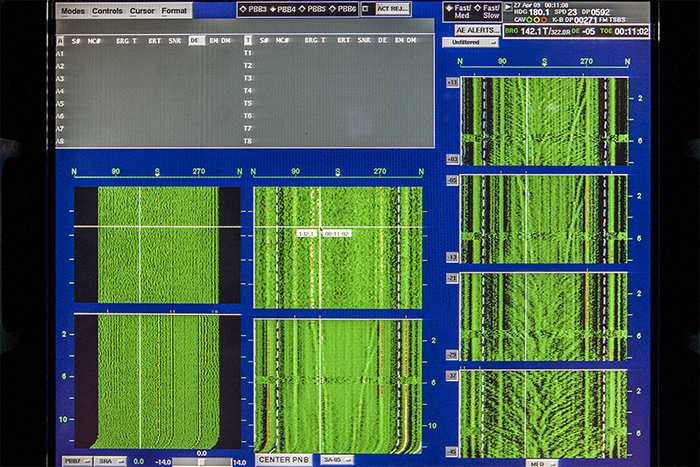
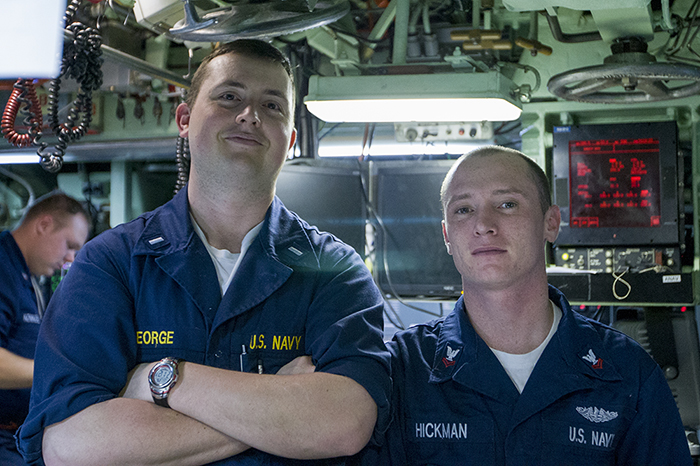
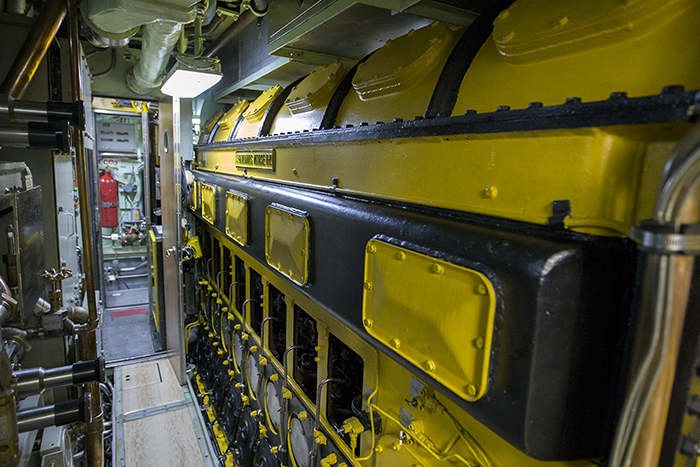
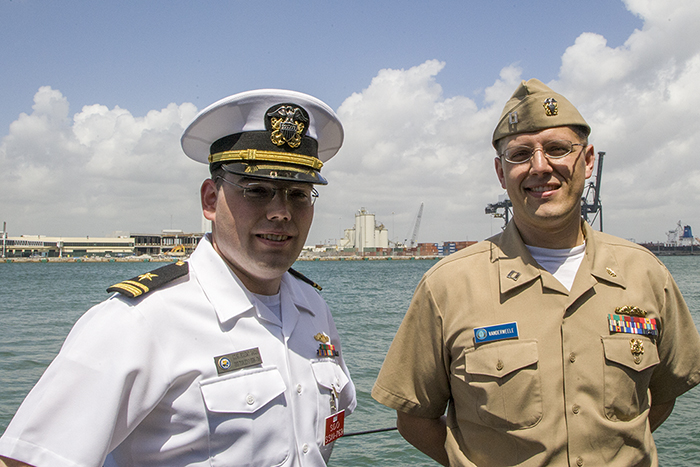
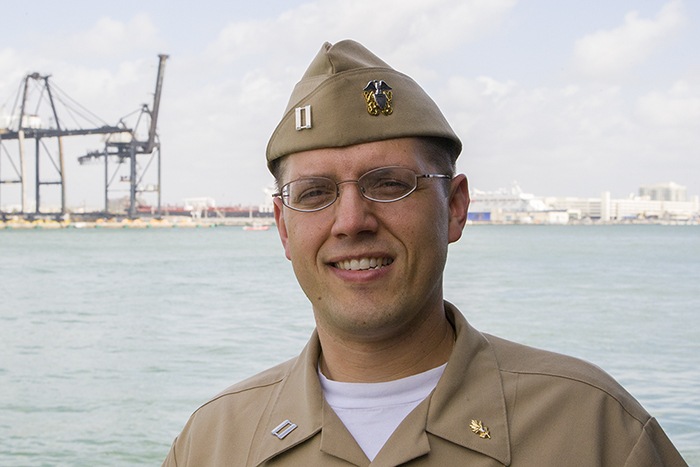
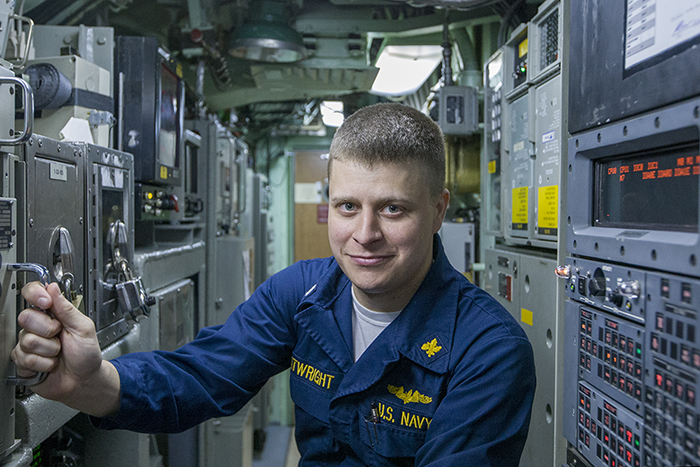
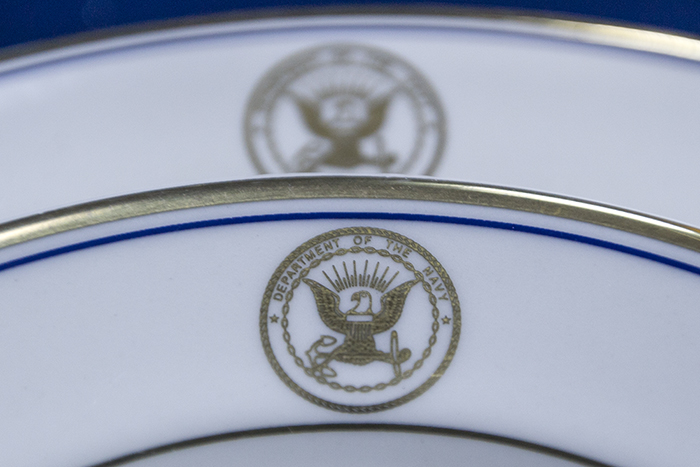
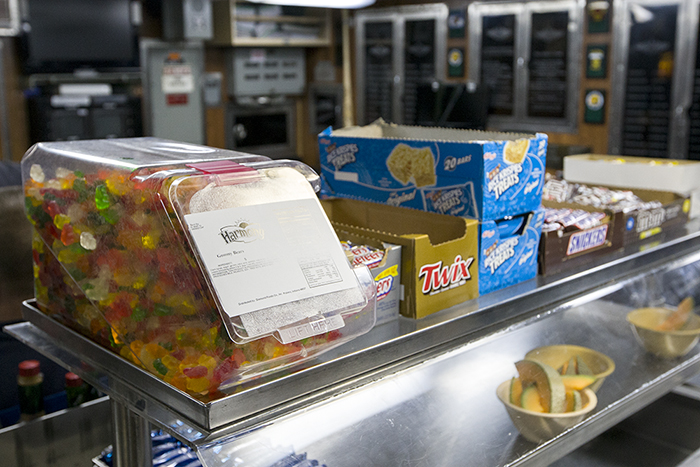

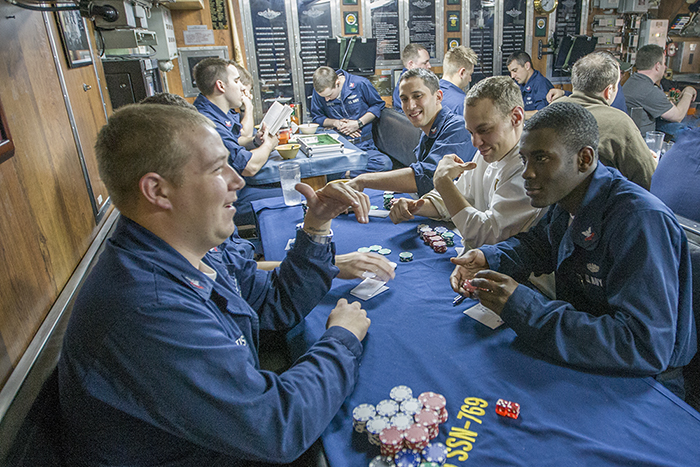
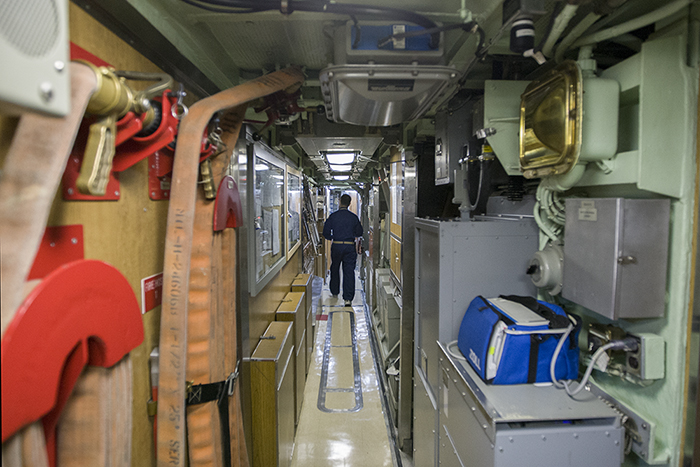
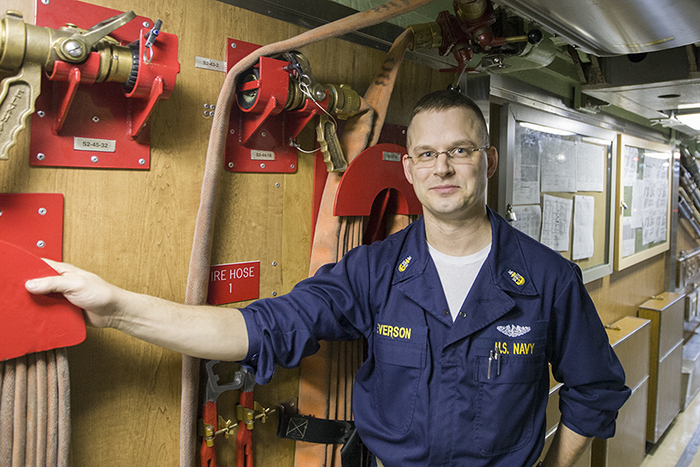
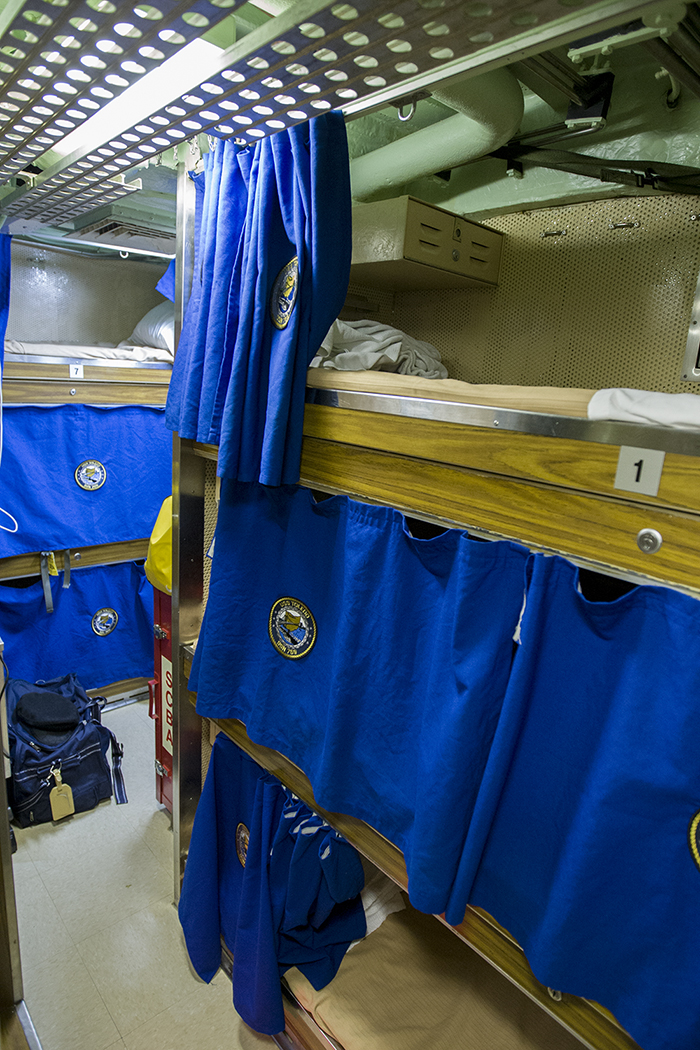
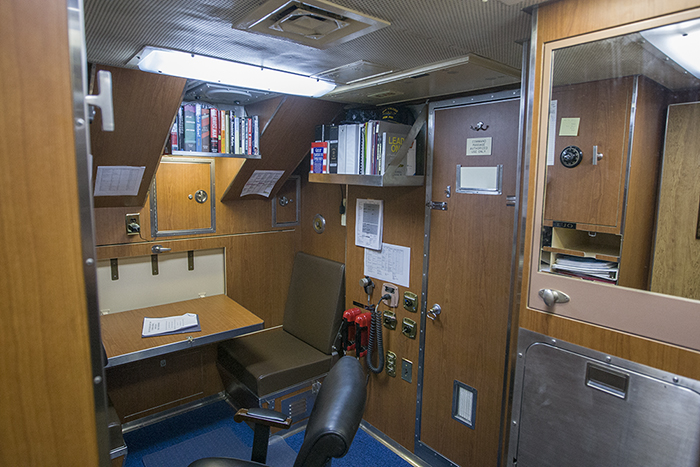
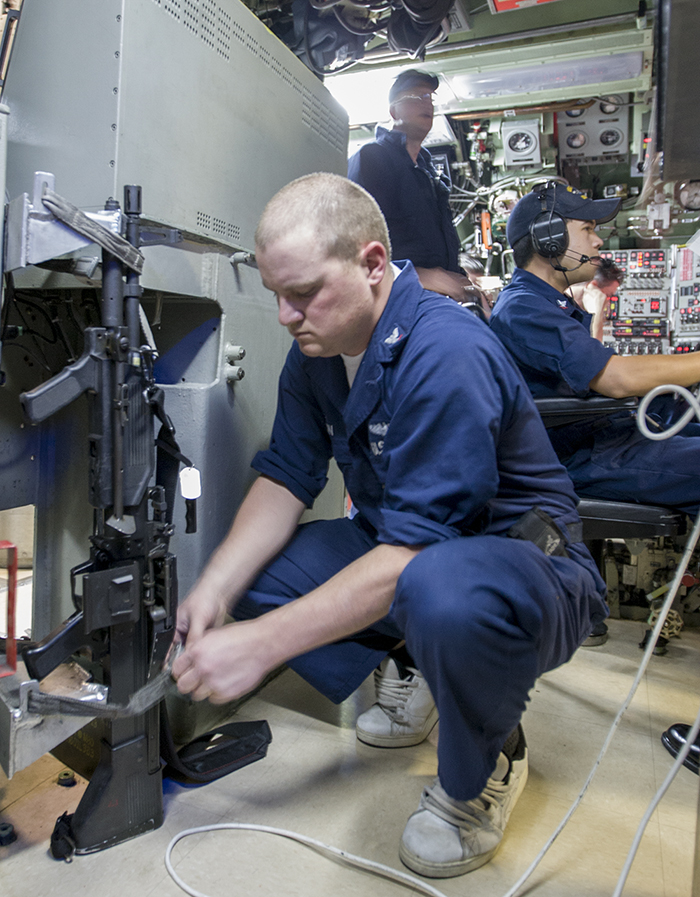
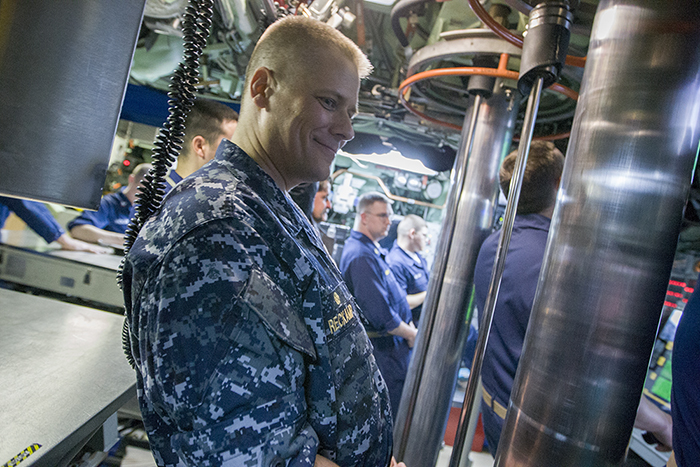
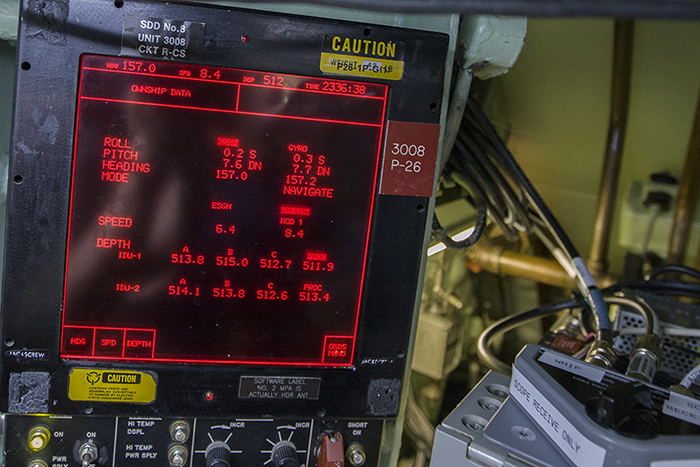
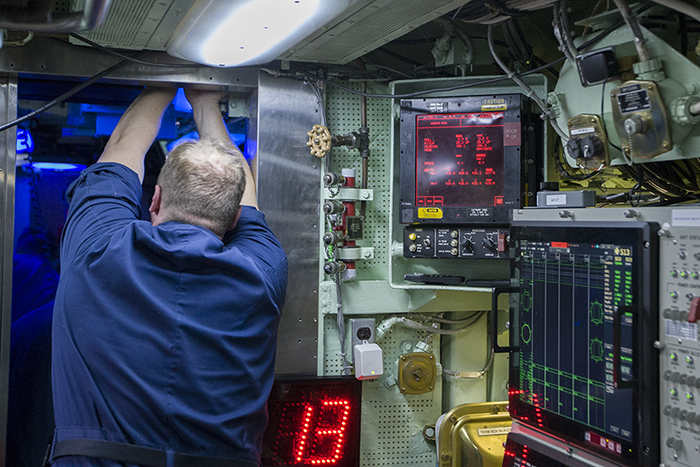
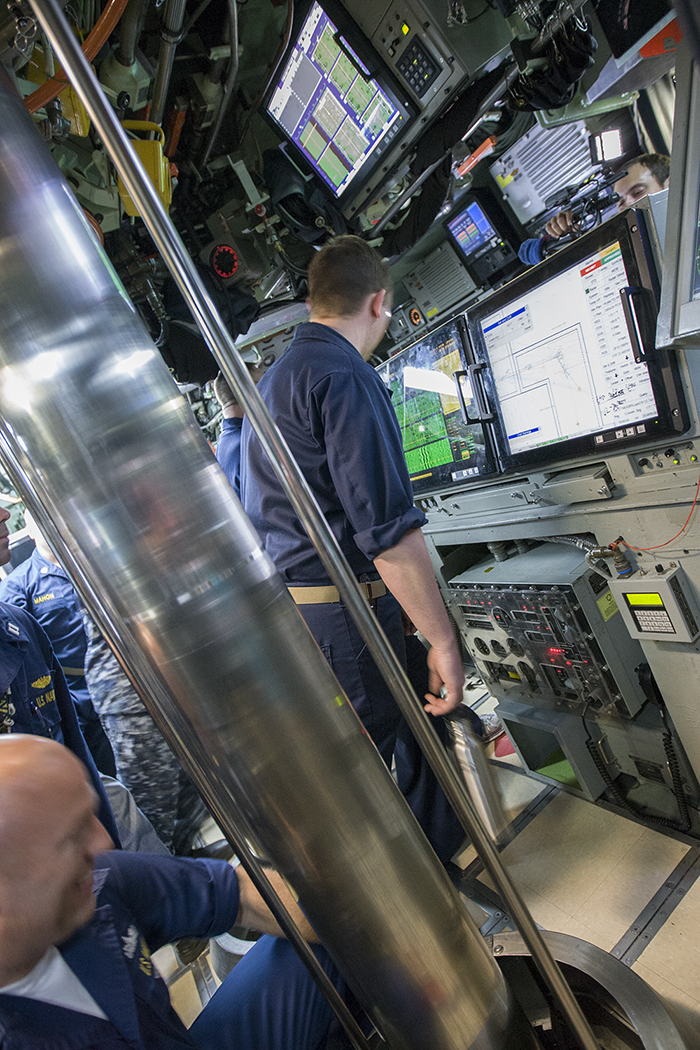
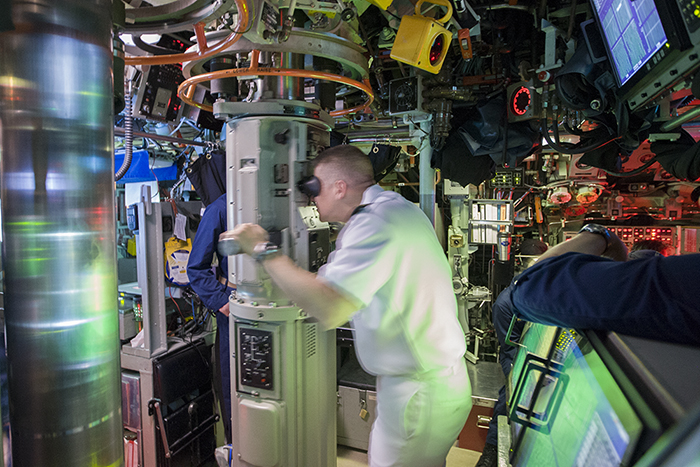
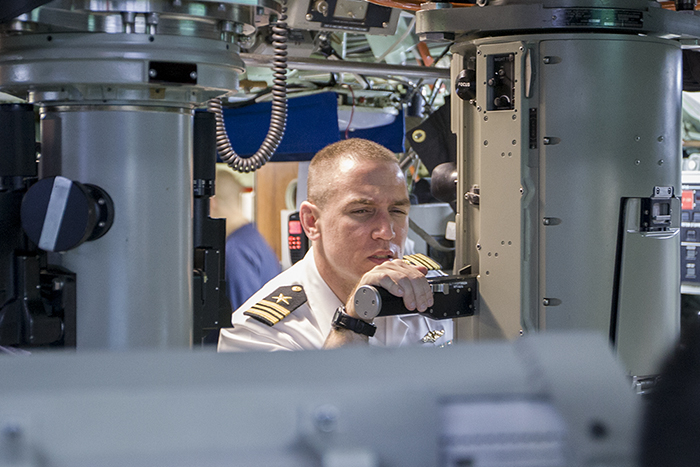
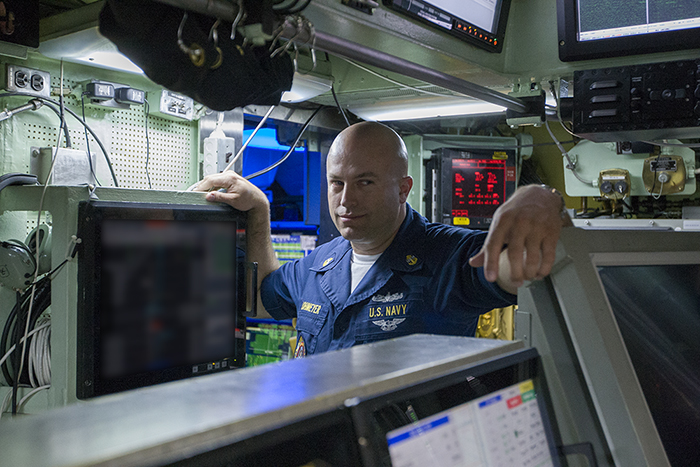
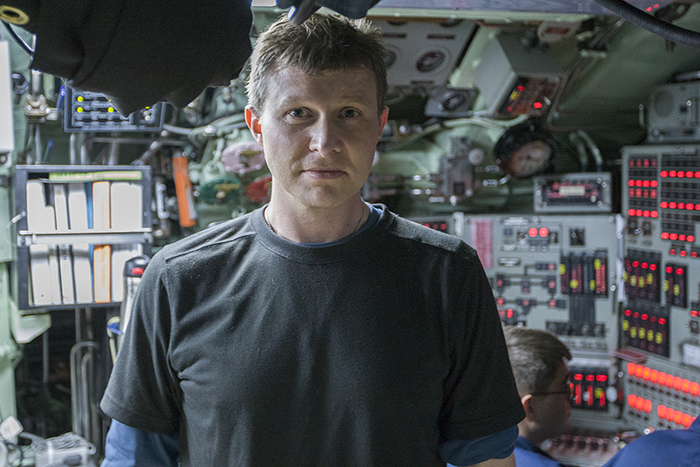
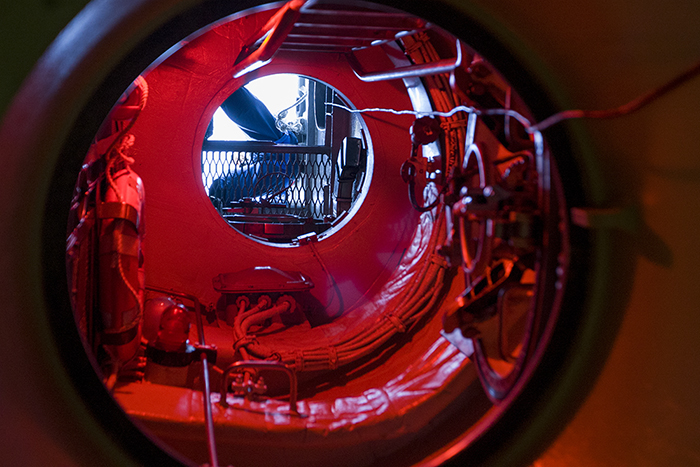
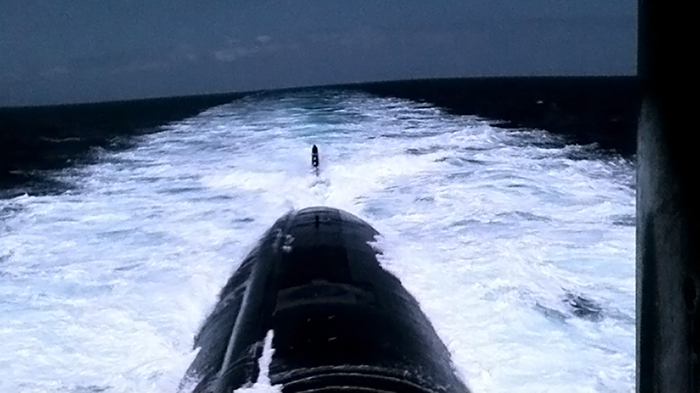
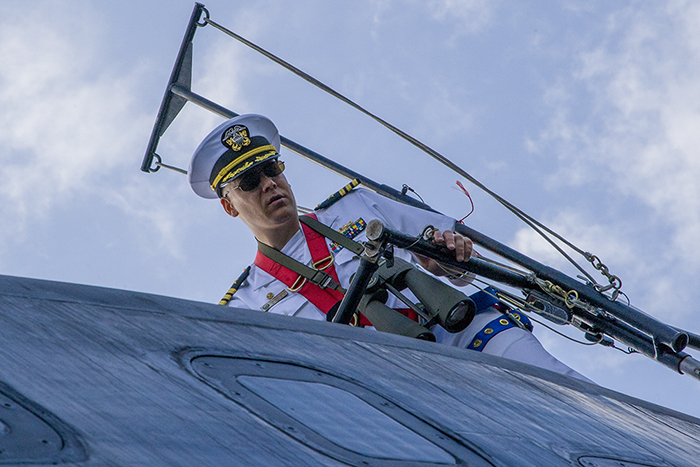
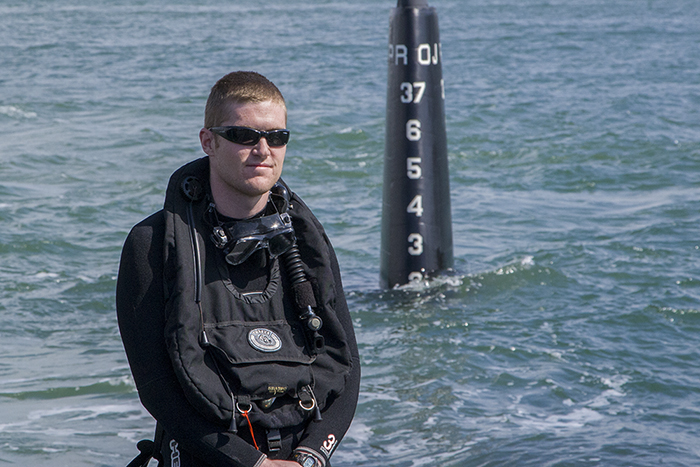
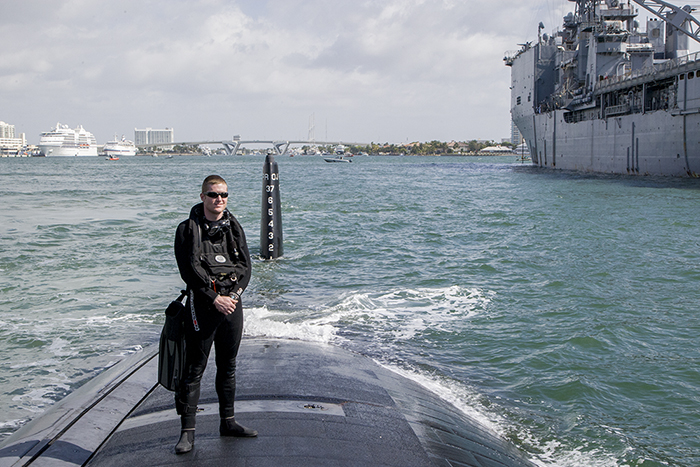
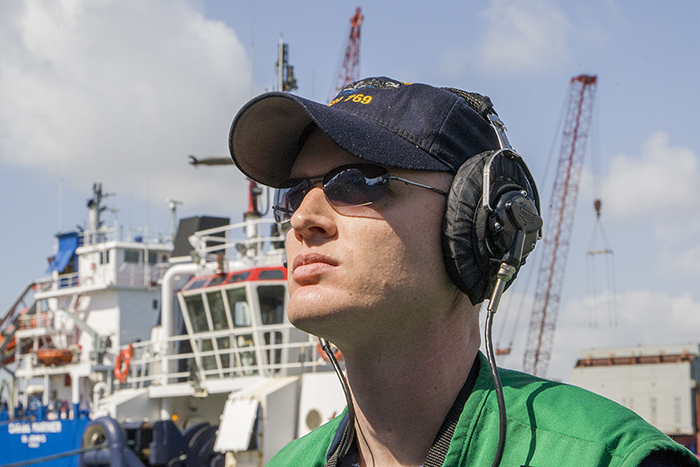
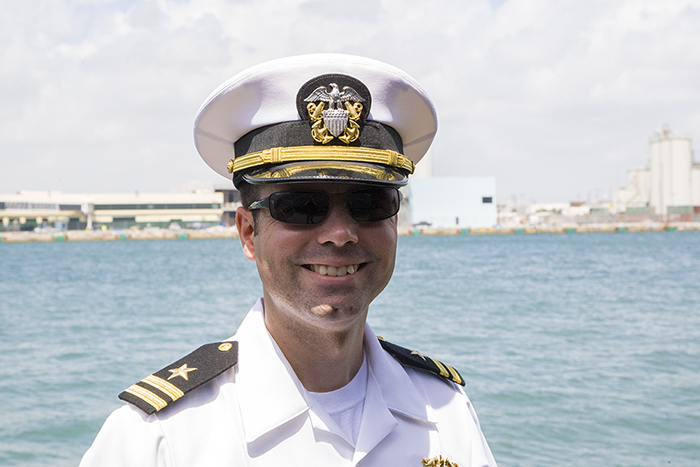
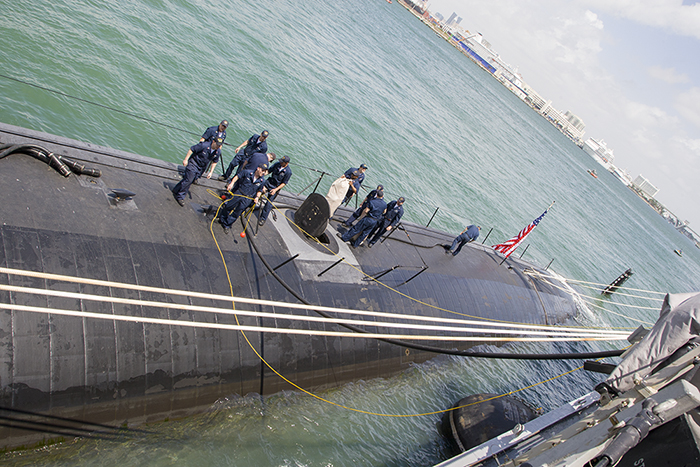
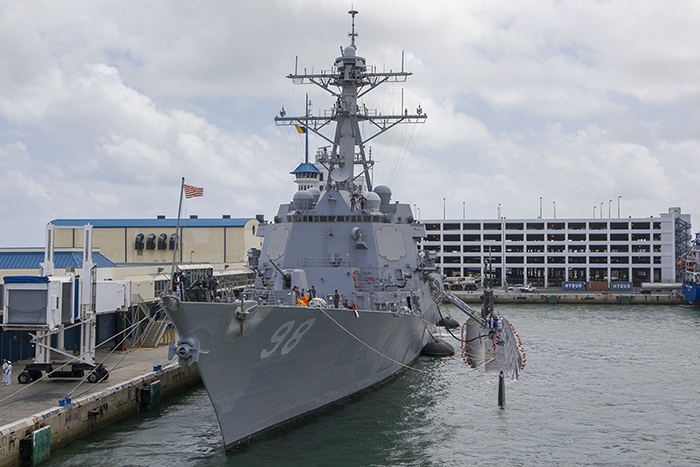
A great article. My son was one of those picked up in the turning basin in Fla. You have given his mom and I a clear insight of the command staff and captain. Thanks.
Thanks for the comment Mike. Who was it? I would love to know who your son was. I spent some time on board and got to know everyone, even the “special” visitors.
Saw your link at /. Thanks so much, wonderful story and pictures.
Very interesting article, and great photos! I’m actually surprised you were allowed to keep and even publish a lot of those photos. Were there things you were told you had to delete?
Great write-up and photos. Also saw this at /.
Luther, Don and trop,
Many thanks. I was granted exceptional access on this trip, though there absolutely were things whose pictures were not allowed to be published. I carefully combed through each image and made sure that there would be no security issues associated with their publication.
That was my boat :)
So glad to read about her. Brings back memories. I was surprised they let you keep the sonar images. They used to be classified.
Going through the pictures, I couldn’t find any of my old shipmates except for maybe one or two but those boats cycle through a lot of people and you have a completely different crew every four or five years.
Hey there.
The images are still classified which is why they were down sampled so no real information could be obtained from them. Chief Roby is now in the Middle East I think, but Justin Evans is still on board. I presume Crd Reckcamp is still boss.
And Justin Evans is still on board to this very day.
And we love him for it. ;-)
Very good story, brought back many memories. I took my family on a tour of a 688I this past summer, my first tour of a boat since sub school 35 years ago.
Thanks for the comment Bil,
What boats were you with?
Thanks! My husband is deployed with his boat currently, and he was attached to it at the time of the article (thought I had not met him at that point yet). I was researching stuff tonight to give me info about what he is going through on the boat since I know so little about what being a submariner is like. This article really helped me feel a little closer to him for a bit.
Hey Hilary,
I wonder if I met your husband when on the boat? There were an awful lot of faces with around 100 people on the boat, but I got to know a few of them.
Glad the article could help out.
Best regards,
I see they still float lol, i used to be on that boat. I still remember all of the crew and glad to see they are well. Hope the best to them and keep at it.
Thanks for the note man. Its a good boat with an even better crew.
bwjones I am looking for an old friend that went in the navy in 98, we lived in Anderson California, I went in the army and only saw him once since 99 would really like to get ahold of him again to catch up, my name is Brandon taylor. either way great articles
What was your friends name? Suppose I might have run into him on the boat if you think that is where he went…
Glad to see my boat still running and though I doubt it but hopefully some of my paint jobs held up for 10 yrs
STS3/ SS, Plankowner, Deck Div LPO 96-97
Thanks for stopping by Russell. I hear the Toledo and her crew are doing quite well.
Wow! Incredible article! I served on the USS Toledo from 2002 to 2006 as a Radioman, and this really brings back a lot of great memories. :)
Thanks Jason! I am processing new images and should have bigger images posted here to replace the 600 pixel wide images. Perhaps sometime tonight.
This is my first and only boat I served in and I had the best shipmates any one can ask for got my fish in six weeks and I was a yn2 (ss) Pagan served from 03 to 07. Couldn’t ask for a better boat
Everyone I met onboard was outstanding. Great crew.
I was actually onboard for this. This was actually my last underway before I got out, what a way to go out with a bang. Nice to see some familiar faces and the good ship Toledo. I hope that diesel still looks as good as it did back then.
MM2(SS) Hernandez
Miguel, did we meet? I met a few “back of the boat” kind of guys when going through the engine room. Was a great trip. Thanks for helping to make it happen *and* keeping the diesels clean. ;-)
Amazing stuff Bryan…AGAIN. I thoroughly enjoy reading your blog. How are there enough hours in the day for you to be a full-time scientist and professional photographer?
Thanks Gabe. I think it comes at the expense of sleep… Still going through some of your images for Webvision. Look for more in the near future.
I am myself both a scientist and a journalist (focused on aerospace technologies and the former Soviet states, mainly) and I have to say this article is beyond amazing—simply beyond. You have provided not only some of the best photographs of life aboard a Navy sub but great commentary on life aboard and the sub fleet’s mission, also. I think this is truly one of the best short-form pieces I’ve read this year so far, period.
Much obliged Mike. You have a link available to your work?
I only served aboard the USS Toledo for 6 weeks back in March/April 1998. It’s a long story so I won’t go into it unless you’d like to hear about it. Those photographs were incredible! They helped me to recall memories I thought had vanished forever. In fact, a few names are coming back to me… MM1(SS) Jean, Chief Fresquez, Senior Chief Chenier. And of course, my Commanding Officer, CDR W.R. Burke who is presently a Vice Admiral. That man must have stood 6 feet 5 inches tall!
I wonders why there were no women on board. I am a veteran and always find this an intereting thing to look for, I was in the Army but my husband was in the Navy.
There are foreign navies that have mixed crews on submarines. I think Germany and the Netherlands do.
Thanks for this posting. It was great to catch up on my old boat. Lots of great pics. I was on the commissioning crew. It was interseting to see what has/has not changed. Did you happen to see any “Spray Nine Men” during your ride?
EM2(SS) Tim Dion, Plankowner SSN-769
Hey Tim,
Thank you and good to hear from you. I have to claim ignorance as to “Spray Nine Men”… Can you enlighten me?
It was a game/hobby that went on during construction involving small squares of cardboard featuring the cartoon spray bottle character from the cases of the all-purpose cleaner Spray Nine. They were hidden in hundreds of locations in out of the way spots. It was sort of a hide-and-seek competition for us folks in the engineroom. Can send pics and more details if you wish.
Ha! That’d be great. Would love to see them.
How can I get them to you?
Great article….I just happen to stumble upon it while doing a search for something at work. Served aboard the good ship Toledo from 1997-2001 in Navigation Division. Great memories from her. ETC(SS)(ret.) Boord, Jeremy L.
Thank you Jeremy.
This is an awesome article. I served aboard the USS Toledo from Dec 1993-Feb 1997 in Machinery Division. I am a Plankowner and am proud to see this boat do so well. I wish you all the very best and safe travels. Oh, is there still a Plankowner plaque in the mess area with all of our names?
Hey David! Nice to hear from you. When I was onboard, there certainly was a plaque with all the Plankowners on it in the mess. I might have gotten a photo of it. Will have to go back through my archives and see if I did.
Remembered I read about your time on the USS Toledo when I started watching this video:
https://youtu.be/RXXMJAU6vY8